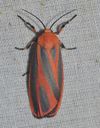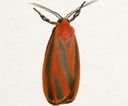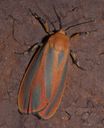Hypoprepia
Hypoprepia
Classification
- Phylum: Arthropoda
- Subphylum: Hexapoda
- Class: Insecta
- Order: Lepidoptera
- Superfamily: Noctuoidea
- Family: Erebidae
- Subfamily: Arctiinae
- Tribe: Lithosiini
- Subtribe: Cisthenina
- Genus: Hypoprepia
Pronunciation
How to pronounce Hypoprepia: /haɪpoʊˈpriːpiə/
These audio files are automatically generated. While they are not always 100% accurate, they are a good starting point.
Images






Summary
Hypoprepia is a genus of moths in the Erebidae family. H. fucosa, known as the painted lichen moth, is a notable species within the genus, first described by Jacob Hübner in 1831. It has a wingspan of 25–35 mm and is typically found in eastern North America, where larvae feed on lichen and moss.
Physical Characteristics
Wingspan of 25–35 mm. Adults have distinct color patterns related to lichen.
Identification Tips
Field marks described in most field guides for the two most widespread species, H. miniata and H. fucosa, are over-simplified and misleading. Careful examination of color pattern is important for accurate identification.
Habitat
Occurs in regions with ample lichen, algae, and moss on trees. Typically found in forested areas and on trees in eastern two-thirds of the US and southern Canada.
Distribution
Widespread throughout the eastern two-thirds of the United States and southern Canada, except for the west coast. H. cadaverosa and inculta are found in the southwestern states.
Diet
Larvae feed on lichen, algae, and moss on trees.
Life Cycle
Overwinters as a larva. Adults are on wing from May to August in northern regions and possibly year-round in Florida.
Ecosystem Role
Roles not specifically mentioned, but as a herbivore, larvae contribute to the ecosystem by feeding on lichen and moss, possibly impacting distribution and health of these plants.
Similar Taxa
- H. miniata
- H. cadaverosa
- H. inculta
Misconceptions
Misleading field guides oversimplify identification for H. fucosa and H. miniata.
Tags
- Hypoprepia
- moths
- Erebidae
- lepidoptera
- larvae
- lichen